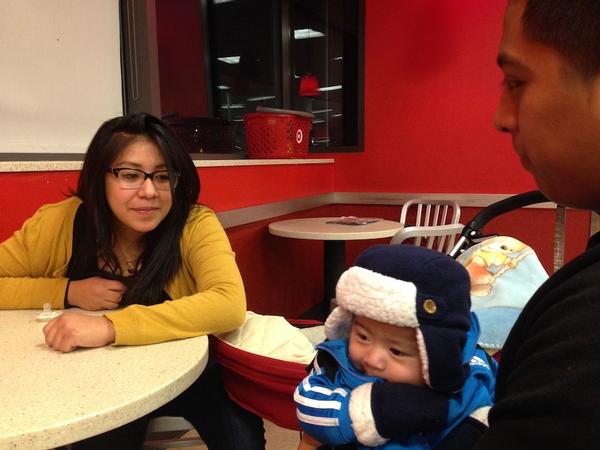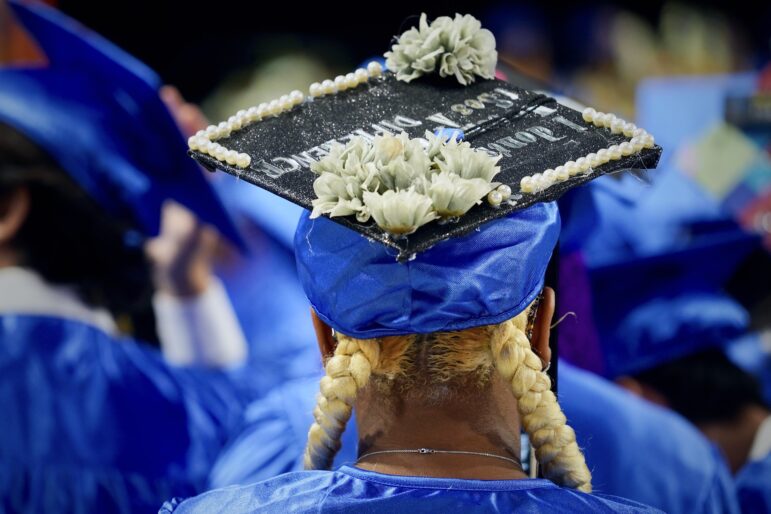
Photo by: Rosa Goldensohn
Ronnie Cortes and Kevin Garcia with son Mason. When their babysitter suddenly quit, it sidetracked Cortes’ career training.
Ronnie Cortes and Kevin Garcia had a system.
While Cortes, 19, worked six hours at a minimum wage job, followed by six hours of high school, Garcia, 20, watched their infant son in the mornings. Then he’d head to work at a nearby supermarket, and a friend’s mom took over the babysitting.
After picking up Mason, Cortes cleaned the half of the room the three share with Garcia’s sister and her child. Then came homework, until 2 a.m. or later.
But recently, their house of cards collapsed.
“The babysitter says, we can’t take care of your kid anymore. And then who am I going to leave my son with?” Cortes says.
When Cortes began missing class to watch Mason, a school social worker encouraged her to apply for city-sponsored day care through the city’s Early Learn program. Early Learn provides care to children under 5 at early education centers.
But in Cortes’ Bedford-Stuyvesant neighborhood, there are about seven eligible children for every spot, according to Early Learn documents from 2011.
That’s better than the citywide average of about 13 per spot in areas that have Early Learn-funded centers. In some neighborhoods, there are up to 40 kids per spot. In many others, there are no spots at all.
Since 2011, the number of children eligible for EarlyLearn spots has only grown. Back then, roughly 290,000 were eligible. Now, some 340,600 are.
ACS puts current Early Learn capacity at 37,000 children. Further complicating matters, ACS said only 29,500 children are enrolled, meaning 20 percent of Early Learn spots go unfilled.
ACS acknowledges what they called the “underutilization of Early Learn,” saying they have no single explanation. “It is an array of issues ranging from program model changes to eligibility requirements to database glitches,” says ACS spokesman Christopher McKniff.
McKniff blames the vacancies partly on a lack of parent interest. “Many parents do not know that their preschoolers will be better prepared for school by attending high quality early education programs offered at many EarlyLearn centers,” he says.
But advocates say there’s huge demand for the slots. Marjorie Momplaisir-Ellis, program director at the Flatbush community organization CAMBA, says wait lists in Flatbush have 50 to 100 students on them, depending on the site.
“The lists would be longer if more families knew about the programs, but only the most visible sites receive applications,” she says. ACS says centers there are at 97 percent capacity.
Demand dwarfs supply
Before Early Learn was implemented, the Administration for Children’s Services had helped low-income parents pay for day care through vouchers and through spots in child care programs at local organizations. Demand outpaced supply under that system, too. But under Early Learn, the provider organizations had to compete for new contracts. The city’s Independent Budget Office estimated in May that 5,500 childcare slots were lost in the shuffle.
In June, the City Council stepped in and restored funding for some centers for the year. This month, Mayor Bloomberg ceded to advocates’ demands by including in his FY 2015 budget $140 million of early education and after-school funding that was set to run out this year. But capacity is still far below demand.
Mayor-elect Bill de Blasio’s campaign was focused on improving access to pre-kindergarten, but children’s advocates say he must prioritize day care for younger infants as well. The Campaign for Children, a coalition of 150 organizations that includes de Blasio advisor Jennifer Jones Austin, released a blueprint last month for the incoming de Blasio administration demanding that the city fund child care for every eligible child under 5.
The day-care gap comes down to a funding shortage, says Greg Brender, a policy expert in early childhood education at United Neighborhood Houses. “The issue with Early Learn was that the city never put in enough money to actually make it work,” he says.
A complex system
When Early Learn was implemented began in 2011, the idea was to funnel kids to especially effective educational programs. Research shows that early education plays a major role in children’s future academic achievement. Early learning exposes children to school basics like numbers and colors, and also teaches them social skills.
New York’s publicly subsidized day care system is complicated. Nobody is getting a check from the city to spend as they like, and families are not guaranteed a slot as they are in the city’s public schools.
To be eligible for EarlyLearn, a household must earn less than two times the federal poverty line; for a two-person household, that’s $31,000 a year. Parents must also either work at least twenty hours a week, attend school or be on public assistance.
ACS said that this requirement was a cause of empty Early Learn seats. “Programs are having some challenges in recruiting families that can meet the eligibility requirements beyond their income,” said McKniff, the ACS spokesman.
Those on public assistance qualify for vouchers that can also be used outside of Early Learn centers. ACS reports that there are about 38,000 children under 5 receiving those vouchers.
But across the board, parents who qualify for either program must find their child a subsidized spot in a private center. They enroll their children directly at a program or join the program’s wait list.
Many eligible parents who don’t manage to snag a public spot at one of the Early Learn centers and don’t qualify for the ACS vouchers pay out-of-pocket for private day care—when they can.
Dana Adams, a special education teacher, runs Stepz 2 Success, a private center in Flatbush that serves 20 children aged 2 to 5 and has a waiting list of six. The program costs $140 to $165 per week.
Most of the mothers she serves work as home health aides. A few parents receive public assistance vouchers. The rest pay out-of-pocket.
Adams says parents sometimes have to pull kids out of the program for a period when they can’t afford it. “When do come back, two or three weeks later, it’s like starting all over. We have a curriculum. They miss a lot,” she says.
Trying to make it work
Parents Cortes and Garcia don’t yet know if they’ll be able to provide their son with the advantage of early education. “My best hope, we just want him to finish school and do good in life, better than I did,” says Garcia, who did not graduate from high school.
They believe that Cortes’ education will help Mason succeed as well. “Hopefully I’ll finish school, and we’ll tell him about our experiences,” says Cortes. “We’ll try our best to guide him down the best path.”
If she can find a place for her son during the day, Cortes could get back on track to graduate in June. She wants to become a nurse.








